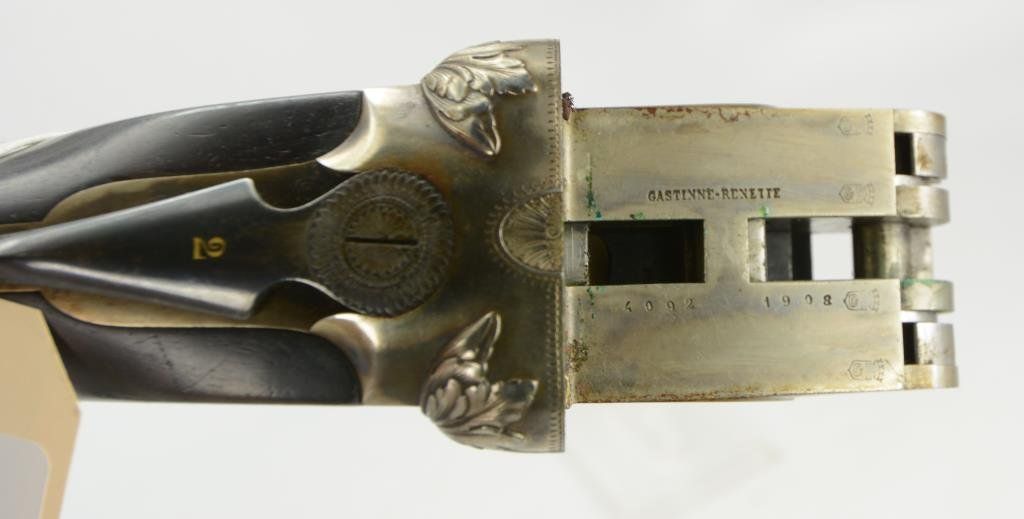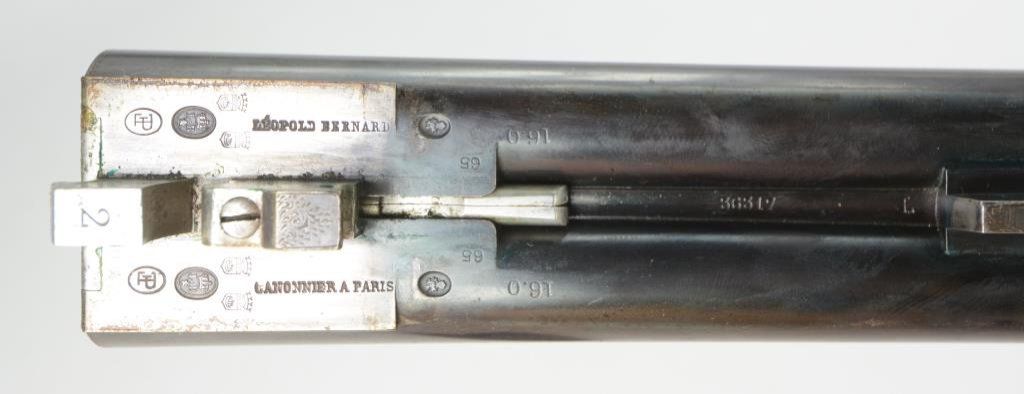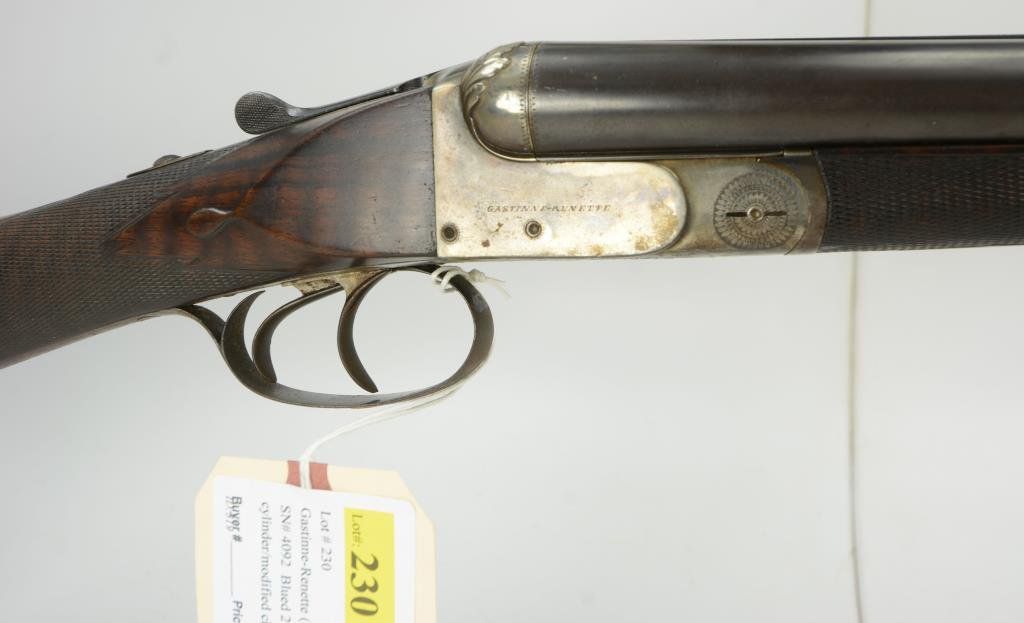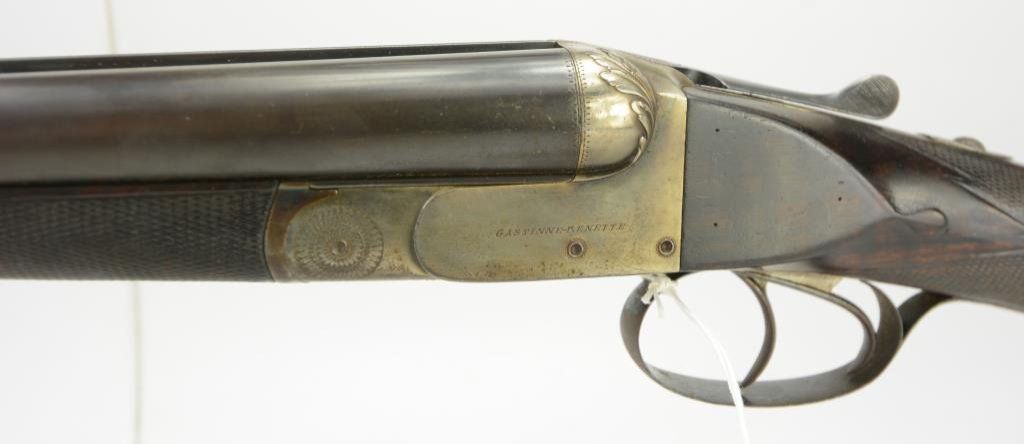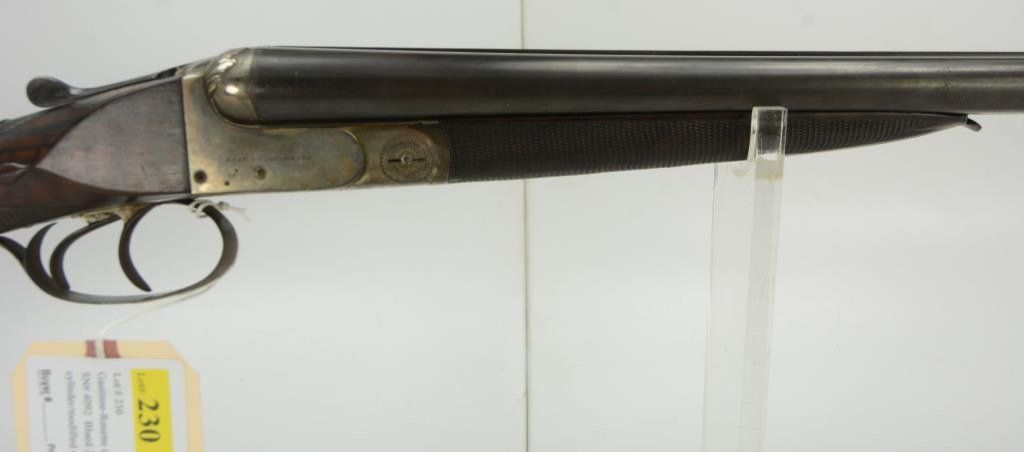According to my proof book it has a "Voluntary provisional proof with a proof pressure of 14,223psi."
The other two side by side marks are described as "For a finished gun that underwent re-enforced proof." Later it gives a pressure for a 16 gauge with such proofs as 14,934psi.
Overall it's a bit confusing, I'm certain others know far more, especially about Paris proof marks.
Steve
That is a great looking gun. Bobby
The EP in an oval is standard proof for barrels "completely finished inside and outside, except the last internal polishing". Pressure is listed as 14,200 psi. However, that's based on information back when they were still measuring pressure with lead crushers (LUP in some older reloading manuals) rather than electronic transducers, which is the current method. So it's more like 15,000+ psi. The mark repeated twice on each side of the flats is definitive black powder proof for a gun in a finished state. Special proof because it's repeated: 11,400 psi (which would again be 12,000+ the way we currently measure pressure).
Canonnier a Paris means barrelmaker in Paris. Leopold Bernard was probably the premier French barrelmaker back then.
What I don't see is a star over P plus another letter, which would indicate the type of smokeless powder used in the proof. Should be there, according to my source, for a gun any newer than about 1896. Not sure why it's not there. Anyone else?
It does look like a nice gun in very good condition, albeit a bit plain considering it's #2 of a pair.
Any clue as to the maker? The best of Gastinne guns were sidelocks made by Granger, in my opinion. However, the Granger guns I have examined were easy to identify from markings.
BillK,
That's a nice 16GA you won! I've never seen a forearm with that style of latch in the front. Could you post some close ups?
A 16 gauge would ordinarily have bores around 16.8mm. (.6614"). The 16.0 mark indicates a bore diameter of .630". That's pretty tight for a 16 gauge.
I have been to Gastinne Renette in Paris a number of times. It is on rue de Franklin Roosevelt next to one of the finest restaurants in Paris. GR used to make guns (some of very high quality), but like many famous Brit 'gunmakers' it is now a retailer of trade built guns, country fashions, etc. They do have a very nice gun room - two, actually.
I do not know whet ether they actually made your gun, more likely that they outsourced the gun. When I was last there, P. Arrizabalaga was making guns for them in Spain.
That is a nice, interesting gun.
Even "back in the day", Gastinne Renette sold guns they didn't make, or had made for them in France. Not at all unusual to see Belgian proofs on a GR-marked gun. But with the Bernard barrels and Paris proofs, this one goes back far enough that it's much more likely that GR played a hand in building it as well as selling it.
I had one GR-marked OU--very nice gun--based on the Petrik design. That's the original design of the OU's with a sliding breech hood which Remington used for the Model 32; Krieghoff since then. The difference with the Petrik OU's is that they were often quite light and designed as field rather than target guns. There's a 16ga on the Safari Outfitters website currently. 28" barrels, weighs less than 5 1/2#.
Thank you all for your input.
Is the number 1908 on the water table a year date or some type of a serial number?
I have not received the gun yet. I will post more detailed pics once I receive it.
BillK
Germain Leopold Bertrand Bernard was born in Versailles 1808 and died 7-11-1870. His firm continued to operate 1870 to 1879 at 49 Rue de Villejust, and in 1889 was at 129 Av de Versailles in Paris but ceased operations in 1890. Other pre-WW I Gastinne Renette doubles have been identified with his mark
and Whitworth steel tubes.
It is not known if another barrel maker acquired the Leopold Bernard trademark after 1890, but clearly
someone did.
c. 1890s Fluid Steel Roblin

Fluid Steel Matska
http://www.doublegunshop.com/forums/ubbt...&PHPSESSID= 
Not much more information here
https://docs.google.com/document/d/1fMs-Mn60ei9QsRcHT5Urm_eHobzJnaDKZiP3FP0fXb0/edit
Chukarman, I guess it's been a while since you've been in Paris. A bunch of my favorite gun shops are no more, including GR. H & H closed their shop on Victor Hugo several years ago too. Over many years I toured them all, even the little out of the way places. Gave me a reason to study French, well the women too of course.
nial
I'd say 1908 is the date on the example with tubes wearing canonnier Léopold Bernard but permit the Galloping Betail Sauvage to concur.
Cheers,
Raimey
rse
Any clue as to the maker? The best of Gastinne guns were sidelocks made by Granger, in my opinion. However, the Granger guns I have examined were easy to identify from markings.
Do you have any evidence of Gastinne Renette guns being produced by G. Granger? That's a new one on me, and while I'm willing to listen and learn, I suspect it isn't supported by any evidence.
Per the bore mm markings (16.0) noted above by Miller, I wouldn't be terribly surprised if the gun is actually a 20 gauge when it shows up. 16.0 is more in line for 20 gauge then for 16 gauge.
Let me state, unequivocally, this gun is not a G. Granger.
It does look like a nice gun.
Best,
Ted
Ted;
I was thinking the same thing about this gun may have been misidentified as to gauge. That 16.0mm would be .015" overbore from nominal for a 20ga but .032" under for a 16. It could of course go either way.
I seriously doubt that it's an 18 gauge, though even in my very meager shell collection I do have one 18ga shell.
That's a good point, Ted. I had an overbored Sauer 20 (A&F import from the 30's) that came fairly close to .630. Correctly stamped 19, so the overbore came as no surprise. And I currently have a Francotte 20 that's stamped 15.9, and the bores check out. Agree with you and Miller that it's more likely to be a 20 than a 16.
I visited GR in Paris during 2001-02, shortly before they closed. We discussed the sourcing of their guns and they confirmed that current SLE's came from both from Granger and their own shop in the basement. They, as did many trade names, sourced as needed (time, money, talent, request by customer, etch.) over the years.
The above gun looks very Liege-ish to my eyes. That is no bad thing, either. I'd guess GR bought it in in-the-white and finished it up in their shop.
If the new owner is interested, I'll run it through my value system - an interesting gun.
DDA
It would be very interesting to see if it is a 16gGA or a 20Ga when it arrives. The Belgian 20GA I own (I have posted pics of it here in the forum) was advertised as a 16GA... It was a nice surprise when I held it in my hands. If this is the case with this one also, it would be my second gun that "shrinked" to a 20GA. I will keep you all posted once I receive it.
Rocketman, yes, I would be interested in running it through your value system. Can you explain it and tell us how it works?
BillK
very nice shotgun!
it all makes sense as a Paris proved gun.
1908 is likely the manufacturing date.
I note the L date code for the Bernard tube set. I think that this date code is early 1900, indicating that the tubeset had been laying around for a little while.
This gun bears no indication that it was made in Belgium, and I would vote for a GR shop made gun.
BTW, the Scott fore-end release is far more French than Belgian.
I am looking forward to seeing more pics.
Best regards,
WC-
I forgot to comment on the 16.0 indicating barrel bore diameter. This is weird, being between 16 and 20 GA...
Please measure the bore when you get it.
WC-
WC, if it's a 1908 gun, why is there no proofmark with P + another letter under a star? Or does that simply indicate that the gun did not undergo smokeless powder proof?
Hi members. I did a number of Google searches for Gastinne-Renette boxlock shotguns and only found a few images of them. There was a 24GA that was auctioned in 2012 by Cowan's Auctions, which is similar in style to mine, although it is of higher quality with lots of engraving. The auction house describes it as a 24 gauge with the barrels marked 14.9 and 1901 on the water table. This puts it close to my recent acquisition with a mark of 1908. It has the same Scott forend latch type as you can see from the pic below. Checkering pattern and stock wrist shape are similar also. Sadly, there were no pics of the barrel flats and action. Below is the auction house description.
"24 gauge, 26" barrels, S/N 4075. 12.25" LOP, highly engraved frame in floral designs interwoven; banner on both sides of the frame with Gastinne-Renette in the banner. Deep relief engraved on the back of the lobes of frame. Safety inlaid in gold. Deep relief engraved triggerguard with gold crest inlaid. Blued barrels with engraving at the breech. Finely checkered highly figured walnut stock with checkered butt. Fully checkered forearm with engraved release. Marked on the frame French proofs and Gastinne-Renette, and the number 4075 and on the front 1901. Bottom of barrels are marked 14.9 on both barrels, and 65 on both barrels along with French barrel proofs and barrel maker Leopold Bernard."
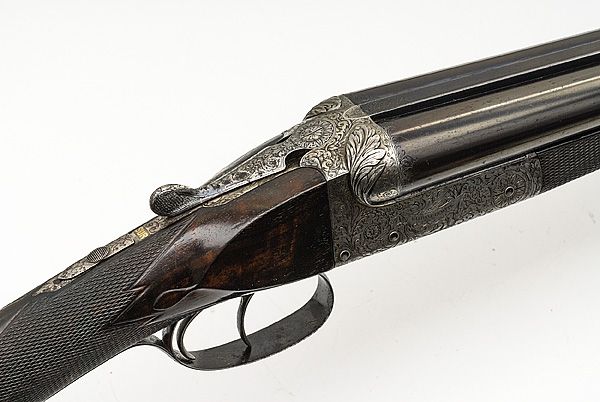
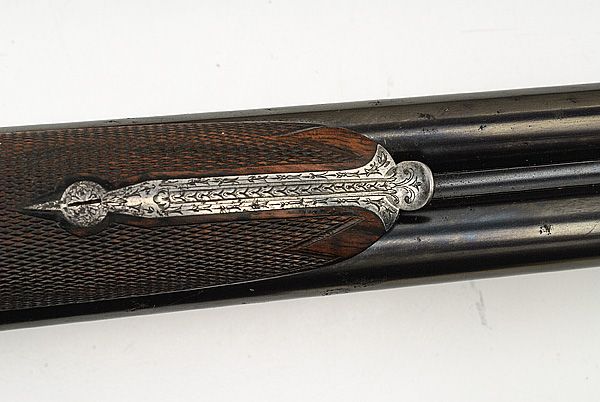
Black powder proof only...
However it was proved reinforced.
Unusual, but certainly not impossible.
WC-
good catch, BillK...
it reinforces my feeling that your gun was a true GR shop made gun.
The numbers line up pretty well. and it is interesting to see that only 17 Serial numbers were taken in 7 years...
At that time, the very bulk of the GR sales were with Belgian and St Etienne made guns, so this kind of makes sense.
It is also possible that both guns were made at about the same time, but yours (and likely its #1 sister) stayed either in stock or unfinished for a long time.
I attribute the LB 'L' date code to 1902 or thereabout.
Note that the fore-end release is identical on both guns, except for the engraving.
I have read somewhere (I think in the Laurent Bedu book), that GR in a banner means shop made. This does not seem to be true, because the 24GA has the banner but the 20 does not, and they were most certainly made in the same place.
All the best,
WC-
BTW this style of forend release can be seen on the Ideal with ejectors. It's called in French "devant a pedale".
see
here for a very similar and contemporary system.
WC-
Galloping Betail Sauvage:
What info have you on the transition from a numeric date-code to a letter system regarding L. Bernard tubesets? Any info where-upon the upper rung tube maker was basing his dating modell? Or was he blazin' his on trail?
Cheers,
Raimey
rse
Nominal 24 gauge is .579" or 14.7mm. Obviously @ 14.9 this 24 gauge was slightly overbore (.587").
Still betting the seller looked at that 16.0 & called it the gauge without further checking, not realizing this was actually the size of the bores in mm.
Rocketman, yes, I would be interested in running it through your value system. Can you explain it and tell us how it works?
BillK
OK, here we go. We can make a pretty good estimate of value, not price, but value based on three factors. Value is an estimate of what price might be whereas price is an agreement between willing buyer and seller. This is based on considerable market research and models. The factors are Brand Value, Original Quality grade, and Current Condition.
BV is based solely on the name on the gun. Before anyone gets in a huff, remember that this is a reflection of the broad market. Ain't my fault, just how the market acts.
OQ is based on a best fit model that has nine pigeon holes ranging from best work SLE to colonial/farmer grade. Grades are far enough apart that they are relatively easy to assign. When there is doubt, it is acceptable to interpolated between two whole number grades.
CC is based on best estimate of which of nine levels fits the gun in hand. Levels range from pristine to wall hanger. As above, levels can be fractional as needed.
The BV of this gun is level three, "most Brit makers and Continental makers with high reputation." GR fits nicely to tis definition. BV3.
OQ looks to me like grade five and a half. That is, between a best work BLE and a second grade BLE. I expect this pair of guns was ordered sans extensive engraving as a style, rather than as a cost saving. OQ5.5.
CC fits nicely as, "heavy use, but no abuse, or remanufactured" which is CC4.
BV3-OQ5.5-CC4 = $2,075. The foregoing from the photographs. Gun in hand may this estimate a bit.
Questions or comments?
DDA
Thank you Rocketman. That is an interesting approach to valuation. Is that a proprietary model you have developed? Would you be willing to share each grade of each component in more detail? How do you derive at assigning the $2,075 value after the analysis of the factors?
I would like to use the valuation model for the rest of my guns.
BillK
What info have you on the transition from a numeric date-code to a letter system regarding L. Bernard tubesets? Any info where-upon the upper rung tube maker was basing his dating modell? Or was he blazin' his on trail?
Hi Raimey,
As we should know by now from previous posts, Bernard has always had a tubeset stamped with a sequential number followed by a '.' and a date.
The date was replaced by a letter datecode at the end of the 19th century. This was before the Belgians did it in 1922.
The only real data I have is that my 1898 dated Rieger has a date code of 'H' and a # 35321.
So at the very earliest, and assuming all letters were used, that would place 'L' at 1902.
By the way, just less than 1000 tubesets went through the Bernard shop in that time frame.
I'll remind people that the shop was held by Leopold's widow for a long time, because he passed on 7/11/1870, just days before the Franco-Prussian war.
Also Bernard seems to have only sold assembled tubesets, and not individual barrels.
Another interesting trivia is that the Paris proof house was actually hosted by the Bernard shop at least at the very beginning.
Best regards,
WC-
Many thanks there Betail Sauvage. Léopold Bernard then may have set the tone for other tube sources like Kilby, Sauer, etc. where the upper rung metals were always sold in serialized sets. So 1000 tubesets & I wonder what type attrition thru the years would result in a residual number now beings a % of the 1000 gross?
Cheers,
Raimey
rse
Hi, BillK. E-mail me at drockerman100@gmail.com and we can continue this discussion.
Yes, it is a model I developed for my own edification in values. Brit and Continental gun values seemed a jumble to me. After my research, I found the model gives a pretty fair estimate of auction prices. I am happy to share for personal use.
The three factors define five sheets of 9 by 9 matrices (405 pigeon holes of value). Once you assign the three factors, you look up a value in the 5 sheets. You can also reverse engineer the value by looking up similar "ask" prices and seeing if the factors indicated make sense.
Use of the charts will sorta "jump-start" your intuitive valuation sense --- at least it did for me.
Drop me a note.
DDA
Hi Raimey,
Who knows how many of those are still around?
Considering the 20th Century turmoils, I would not be surprised if less than 10% of the fare was still around. Probably much less, actually...
I don't recall having ever seen an LB stamp on a single barrel...
It does not mean that the shop did not sell those as individual tubes to the trade, but I sincerely doubt it as high ends makers tend to like to capture all the value they can.
Best regards,
WC-
WC:
And me thinks that there was more success in offering knitted tubesets with regard to liability, where a tube may be compromised when improperly joined, if peddled in singles.
Have you the Léopold Bernard ledger?
Cheers,
Raimey
rse
I sure wish I had access to the ledgers.
My data is based on the forensics (i.e guns).
WC-
Empirical eh? If any one possessed it, I would have thought it to be you.
Cheers,
Raimey
rse
The Gastinne-Renette is on the UPS truck and should arrive on Friday. I can't wait to open the box and find out if I got another 16 gauge or 20 gauge. By then it would be almost 2 weeks since the auction took place. Patience is wearing out!!
BillK
Holy smokes, just look at the quality of that checkering on that gun.
2 1/2" shells are not necessary if you will load low pressure 2 3/4" shells. Do not imply low pressure from light shot load; they do not necessarily go together. I've nothing against 2 1/2" shells; they are period correct. They are also more complicated and add complexity to your shooting.
DDA
If you reload "low pressure" 2 3/4", remember to build in an extra safety cushion. Per Bell's tests with long shells in short chambers, reported in Double Gun Journal, the extra length of a 2 3/4" hull in a 2 1/2" chamber can result in a pressure increase of 1,000 psi. It's a bit harder to get really low pressures with a 20ga than with a 12ga, but there are recipes out there. And given the weight of that gun, if you're shooting targets, you'll probably really like 3/4 oz reloads. Easy to do with Claybuster's 3/4 oz wads.
Pretty sure Mark Larson can make the extension disappear. Looks to need a new pad anyway.
Nice gun. Fair warning, you will spend a lot of time looking for number one!
I would wager that you will find the barrel walls to have substantial thickness, it was typical on French guns. Low pressure is a good thing, but, takes on less urgency with a French double gun that has .050-.080 barrel walls, 9 inches from the breech.
Best,
Ted
Do you have Mark's information?
As long as the gun has adequate barrel thickness, which with the proofs it has it probably does, extend the forcing cones and then go ahead and shoot 2-3/4" shells through it. That solution has always worked great for me. With modern thin walled plastic cases, extending the forcing cones is a good idea for better patterns even if you stick with 2-1/2" shells.
Steve
It has been my casual observation that as we doublegun guys age (and, drop off) that most prefer to spend their money on unmodified guns.
We have a nice selection of Uggies, and Muslim (Turkish) guns that can be modified to our hearts content. But, an original French gun with a pedigree like this one has is a bit harder to find.
Not saying that the owner shouldn't modify it to suit his needs, but, do that with clear thoughts of just what he has.
Just sayin'...
Best,
Ted

